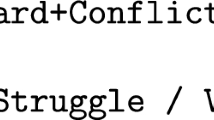Abstract
Although the narrative structure of common entertainment products like Hollywood movies or TV series is generally composed of a number of different plot lines combined into a single narrative discourse, efforts on computational modeling of story generation have to this point focused mostly on the construction of stories with a single plot line. The present paper explores an evolutionary solution to the task of building a story that combines more than one plot line into a single linear discourse. This requires: a set of knowledge resources that capture the main features that influence the decisions involved, a representation suitable for evolutionary treatment for discourses with several plot lines, and a set of fitness functions based on metrics related to the quality of the resulting discourses. The proposed solution produces populations of stories with elaborate discourses that combine several subplots.
This paper has been partially funded by the projects CANTOR: Automated Composition of Personal Narratives as an aid for Occupational Therapy based on Reminescence, Grant. No. PID2019-108927RB-I00 (Spanish Ministry of Science and Innovation) and InVITAR-IA: Infraestructuras para la Visibilización, Integración y Transferencia de Aplicaciones y Resultados de Inteligencia Artificial, UCM Grant. No. FEI-EU-17-23.
Access this chapter
Tax calculation will be finalised at checkout
Purchases are for personal use only
Similar content being viewed by others
Notes
- 1.
For clarifications on how romantic conflicts are handled in the current version of the system see the discussion in Sect. 3.6.
References
Balló, J., Pérez, X.: La semilla inmortal: los argumentos universales en el cine. Ed. Anagrama, Barcelona (2007)
Concepción, E., Gervás, P., Méndez, G.: Exploring baselines for combining full plots into multiple-plot stories. New Generation Computing 38(4), 593–633 (2020). https://doi.org/10.1007/s00354-020-00115-x
Fay, M.P.: Driving story generation with learnable character models. Ph.D. thesis, Massachusetts Institute of Technology (2014)
Fredericks, E.M., DeVries, B.: (Genetically) improving novelty in procedural story generation. arXiv preprint arXiv:2103.06935 (2021)
Gervás, P.: Storifying observed events: could i dress this up as a story? In: 5th AISB Symposium on Computational Creativity. AISB, AISB, University of Liverpool, UK, April 2018
Gervás, P.: Composing narrative discourse for stories of many characters: a case study over a chess game. Literary Linguist. Comput. 29(4), 511–531 (2014)
Gervás, P.: Generating a search space of acceptable narrative plots. In: 10th International Conference on Computational Creativity (ICCC 2019). UNC Charlotte, North Carolina, USA, July 2019
Gervás, P., Concepción, E., Méndez, G.: Assessing multiplot stories: from formative analysis to computational metrics. In: 12th International Conference on Computational Creativity (ICCC 2019), Mexico City, Mexico, September 2021
Hervás, R., Sánchez-Ruiz, A.A., Gervás, P., León, C.: Calibrating a metric for similarity of stories against human judgement. In: ICCBR (Workshops), pp. 136–145 (2015)
Kartal, B., Koenig, J., Guy, S.J.: User-driven narrative variation in large story domains using Monte Carlo tree search. In: Proceedings of the 2014 International Conference on Autonomous Agents and Multi-agent Systems, AAMAS 2014, pp. 69–76. International Foundation for Autonomous Agents and Multiagent Systems, Richland, SC (2014)
Lehman, J., Stanley, K.O.: Exploiting open-endedness to solve problems through the search for novelty. In: Proceedings of the Eleventh International Conference on Artificial Life. MIT Press (2004)
de Lima, E.S., Feijó, B., Furtado, A.L.: Procedural generation of quests for games using genetic algorithms and automated planning. In: 18th Brazilian Symposium on Computer Games and Digital Entertainment, SBGames 2019, Rio de Janeiro, Brazil, 28–31 October 2019, pp. 144–153. IEEE (2019). https://doi.org/10.1109/SBGames.2019.00028
McIntyre, N., Lapata, M.: Plot induction and evolutionary search for story generation. In: Proceedings of the 48th Annual Meeting of the Association for Computational Linguistics, pp. 1562–1572. Association for Computational Linguistics, Uppsala, Sweden, July 2010. https://aclanthology.org/P10-1158
Peinado, F., Francisco, V., Hervás, R., Gervás, P.: Assessing the novelty of computer-generated narratives using empirical metrics. Minds Mach. 20(4), 588 (2010). https://doi.org/10.1007/s11023-010-9209-8
Pérez y Pérez, R., Sharples, M.: Mexica: a computer model of a cognitive account of creative writing. J. Exp. Theor. Artif. Intell. 13(2), 119–139 (2001)
Porteous, J., Charles, F., Cavazza, M.: Plan-based narrative generation with coordinated subplots. In: European Conference on Artificial Intelligence (ECAI 2016), vol. 285, pp. 846–854. IOS Press (2016)
Reiter, E., Dale, R.: Building Natural Language Generation Systems. Cambridge University Press, Cambridge (2000)
Gómez de Silva Garza, A.: An evolutionary approach to design case adaptation. Ph.D. thesis, The University of Sydney, Australia (2000)
de Silva Garza, A.G., y Pérez, R.P.: Towards evolutionary story generation. In: Colton, S., Ventura, D., Lavrac, N., Cook, M. (eds.) Proceedings of the Fifth International Conference on Computational Creativity, ICCC 2014, Ljubljana, Slovenia, 10–13 June 2014, pp. 332–335. computationalcreativity.net (2014). http://computationalcreativity.net/iccc2014/wp-content/uploads/2014/06/15.3_Garza.pdf
Tapscott, A., Gomez, J., León, C., Smailovic, J., Znidarsic, M., Gervás, P.: Empirical evidence of the limits of automatic assessment of fictional ideation. In: C3GI ESSLLI (2016)
Author information
Authors and Affiliations
Corresponding author
Editor information
Editors and Affiliations
Rights and permissions
Copyright information
© 2022 The Author(s), under exclusive license to Springer Nature Switzerland AG
About this paper
Cite this paper
Gervás, P., Concepción, E., Méndez, G. (2022). Evolutionary Construction of Stories that Combine Several Plot Lines. In: Martins, T., Rodríguez-Fernández, N., Rebelo, S.M. (eds) Artificial Intelligence in Music, Sound, Art and Design. EvoMUSART 2022. Lecture Notes in Computer Science, vol 13221. Springer, Cham. https://doi.org/10.1007/978-3-031-03789-4_5
Download citation
DOI: https://doi.org/10.1007/978-3-031-03789-4_5
Published:
Publisher Name: Springer, Cham
Print ISBN: 978-3-031-03788-7
Online ISBN: 978-3-031-03789-4
eBook Packages: Computer ScienceComputer Science (R0)




